How to visit Ukraine’s UNESCO World Heritage Sites independently (without taking a tour)
There are seven properties inscribed on the UNESCO World Heritage List in Ukraine. Six are cultural, and one is natural:
Kyiv: Saint-Sophia Cathedral and Related Monastic Buildings, Kyiv-Pechersk Lavra (1990)
L’viv – the Ensemble of the Historic Centre (1998)
Struve Geodetic Arc (2005)
Ancient and Primeval Beech Forests of the Carpathians and Other Regions of Europe (2007,2011,2017)
Residence of Bukovinian and Dalmatian Metropolitans (2011)
Wooden Tserkvas of the Carpathian Region in Poland and Ukraine (2013)
Ancient City of Tauric Chersonese and its Chora (2013)
Map locating all of the World Heritage Sites in Ukraine
We have visited four out of Ukraine’s seven UNESCO sites, five if you consider our visit to the geodetic arc in Hammerfest in Norway to be a ‘seen one, seen ‘em all’ tick the box. Most of the sites are easy to fit into a regular sightseeing schedule but two of them – the Struve Geodetic Arc and Beech Forest of the Carpathians – are superficially less appealing but have hidden depths if you take the time to appreciate them, and visiting the Ancient City of Tauric is complicated by politics.
A walkthrough of the UNESCO World Heritage Sites in Ukraine
Kyiv: Saint-Sophia Cathedral and Related Monastic Buildings, Kyiv-Pechersk Lavra (1990)
Location: Kyiv, Ukraine’s capital
St. Sophia Cathedral and the Kyiv-Pechersk Lavra are two of Kyiv’s most eye-catching sights so regardless of whether you are chasing UNESCO World Heritage Sites in Ukraine or just sightseeing, there is a good chance they are on your list of places to visit.
Capped with green and gold onion-shaped domes, St. Sophia was built in 1037 and is Kyiv’s oldest standing church. It was built by Prince Yaroslav the Wise, and his tomb is inside the church, although the original mosaics and frescos are the most striking feature inside the cathedral. The church is through a 76-metre-tall bell tower, which was a late-17th-century addition. The bell tower’s baby blue baroque-style exterior is more ornate than that of the cathedral and is well worth climbing up the internal stairs for a birds-eye view of the cathedral and across Kyiv.
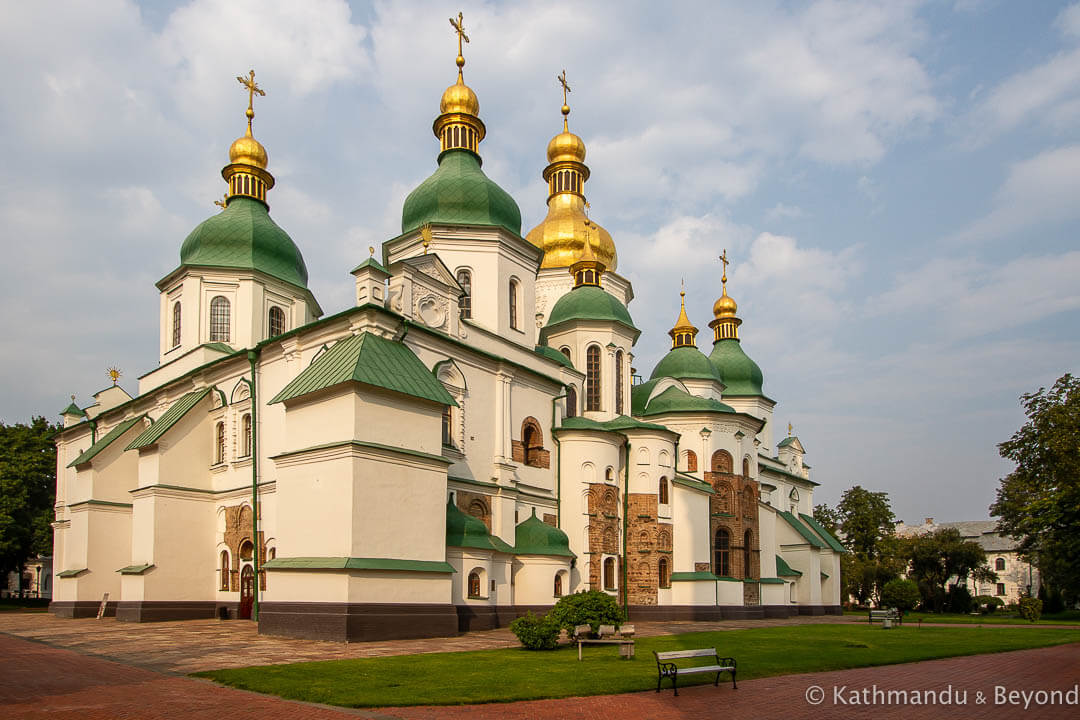
St. Sophia Cathedral in Kyiv
Kyiv-Pechersk Lavra has several spelling variants, and is also known as the Monastery of the Caves – lavra is the name given to important monasteries and pechersk translates to ‘of the caves’. The historic Orthodox monastery was founded in 1051 by St Antony when a series of catacombs and cave dwellings were dug out for monastic life. The mummified bodies of St Antony and his close followers lay in the cave tombs and are one of the holiest parts of the lavra complex. Above ground, the lavra comprises several buildings, the most impressive of which is the Dormition Cathedral built a couple of decades after the caves.
Given its importance as a lavra, the complex attracts pilgrims and religious tourists as well as regular ones. It is a large site consisting of the Upper Lavra and the Lower Lavra, and you should set aside around three hours for your visit.
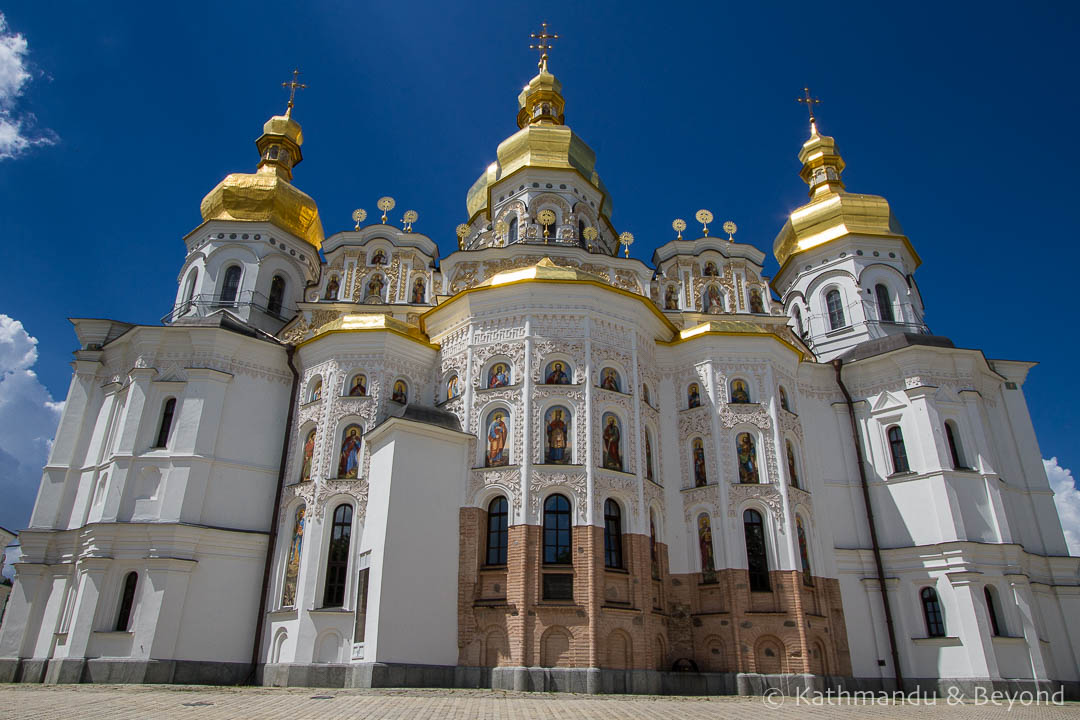
Dormition Cathedral at the Kyiv-Pechersk Lavra
How to get to Saint-Sophia Cathedral in Kyiv and visiting information
Centrally located St. Sophia is one of Kyiv’s must-visit sights and is easy to include on a walking tour of the city.
The closest Metro stations to St. Sophia are Zoloti Vorota (Golden Gate) and Maidan Nezalezhnosti (Independence Square). Both are a 5 to 10-minute walk, although Zoloti Vorota is the closer of the two. Alternatively, take bus 24A to Sofiiska Square. You can also use EasyWay to work out the best way to reach St. Sophia Cathedral from wherever you are in Kyiv.
Saint Sophia Opening hours and Entrance cost
Saint Sophia Cathedral is open from 10am to 6pm except on Thursday when it is closed and on Wednesday when it shuts an hour earlier.
Admission, including the cathedral and the Refectory exhibition halls, costs 180 UAH for adults and 60 UAH for students and children. Entrance to the Bell Tower is a further 60 UAH adults (20 UAH students and children). You can also pay for access to only the grounds, which costs 20 UAH (this is useful if you want to photograph the exterior at different times of the day or feel like a quiet hour or so on a shady bench). There are various additional ticket charges for some of the other buildings. All ticket prices can be checked on the St. Sophia Cathedral Museum website.
How to get to Kyiv-Pechersk Lavra in Kyiv and visiting information
The Lavra is a little further from the centre of Kyiv than St. Sophia, but some of the city’s key sights are in the same area, especially if you are interested in Kyiv’s modern history (the Motherland Monument and National Museum of the History of Ukraine in the Second World War) and Soviet-era architecture (the Salute Hotel).
The closest metro station to Kyiv-Pechersk Lavra is Arsenalna which is a 15-20 minute walk from the monastery complex. There are several buses (24, 24A, 38, 470, 520) you take to avoid the walk, but then you’d miss out on experiencing the 105.5 metre Arsenalna underground station, the deepest in Europe and only a few metres short of North Korea’s Pyongyang 110 metre Metro, the deepest in the world.
Kyiv-Pechersk Lavra Opening hours and Entrance cost
The Lavra is open from 9am to 7pm daily. Opening and closing times of ticket offices and some buildings vary.
A basic ticket which includes entrance to the complex and grounds costs 80 UAH per adult whilst the 130 UAH ticket also includes entrance to the Bell Tower. You can purchase various additional tickets which include guided tours or photography and video permissions (not required for personal photography). There is no additional charge for visiting the caves. Check up-to-date ticket prices.
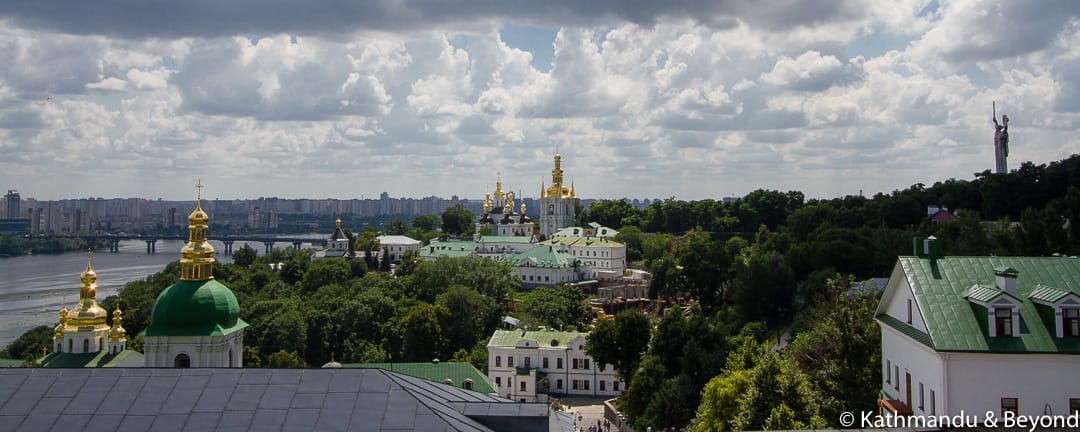
View of Kyiv-Pechersk Lavra
L’viv – the Ensemble of the Historic Centre (1998)
Location: Lviv in Western Ukraine
Very few people would dispute that Lviv is Ukraine’s prettiest city (although there are also plenty of alternative things to do in Lviv). Just seventy kilometres east of the Polish border, its buildings are more the style of those you’d find in Poland or the Czech Republic. Founded in the Middle Ages, much of Lviv’s heritage is Polish and Austro-Hungarian and the city only became part of the Soviet Union in 1939 as a consequence of the German-Soviet invasion.
UNESCO state “the medieval urban topography has been preserved virtually intact (in particular, there is evidence of the different ethnic communities who lived there), along with many fine Baroque and later buildings”.
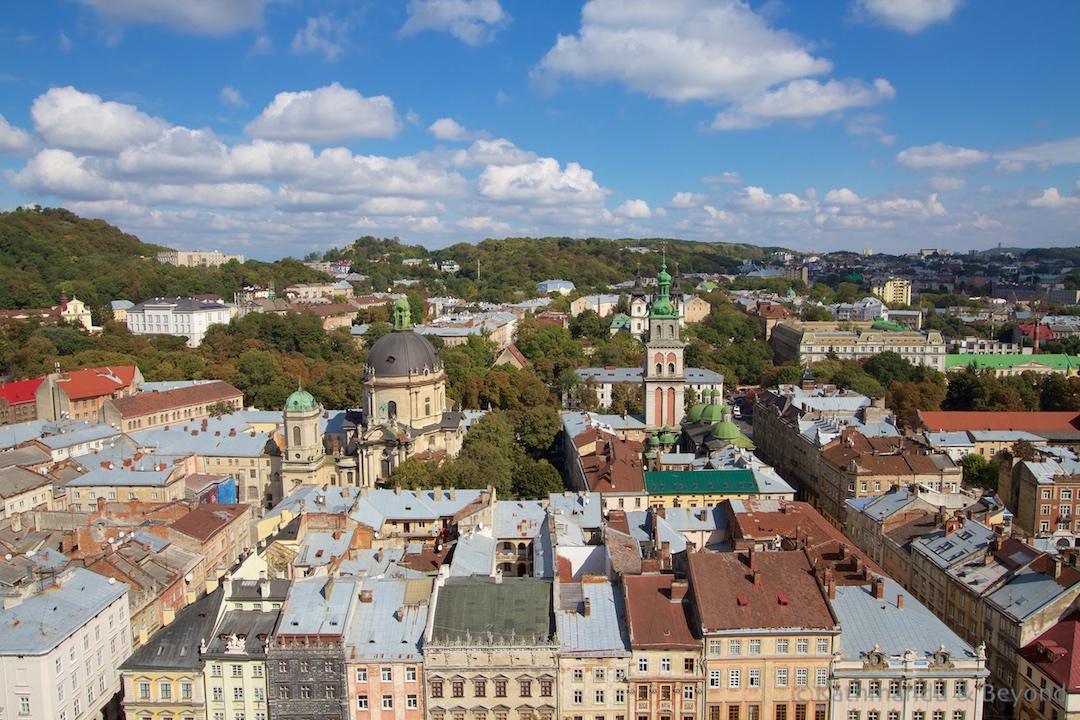
View across Lviv’s historic old town
Lviv is awash with landmarks and buildings included in the UNESCO listing and the city’s historical landmarks number over 2,000, of which 214 are listed as national landmarks. That’s a lot of sites to tick off! To make it easier, the UNESCO listing highlights three separate areas each representing different stages in the city’s development:
Vysokyi Zamok (High Castle) and Pidzamche (the area around the castle). This is the original city centre and the oldest part of the town, dating back to the 5th century. There are several historic churches in this part of town.
Seredmistia (Middletown) developed as the city centre in the 14th century and has many well-preserved Eastern European buildings. This area is considered the Old Town and includes Market Square, the Armenian Church, the Church of Assumption, St. Andrew’s Church (Bernardine Monastery), Dominican Church, and the city’s fortifications including the Arsenal, the Turners’, and Ropemakers’ Towers.
The Ensemble of St. Yuri including St. George’s Cathedral. Located on a plateau just to the southwest of the medieval city, many of the buildings in this part of the city are Baroque in style.
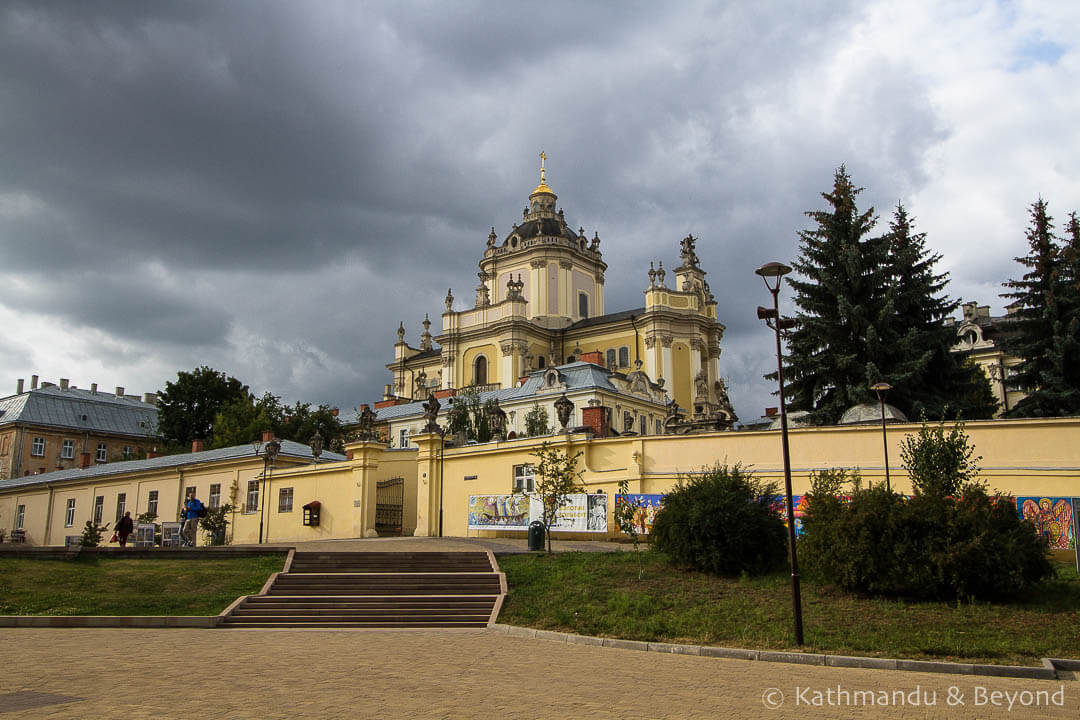
St.George’s Cathedral, Lviv
How to get to Lviv’s Ensemble of the Historic Centre and visiting information
Lviv is easy to reach by bus or train from Kyiv, and many other parts of the country. It is also straightforward to cross the land border between Poland and Ukraine, making Lviv accessible from Warsaw and Krakow. Once in Lviv, the ensemble of the historic centre is UNESCO-speak for the old town and the key sights should be easy to find.
Struve Geodetic Arc (2005)
Location: Khmelnytsky Oblast and Odesa Oblast
The Struve Geodetic Arc is a UNESCO listing shared with nine other countries. Although the revelations of the Struve Geodetic Arc are not to be sniffed at, this UNESCO site is the least exciting to visit because there is not much to see at each location, other than a monument or marker post.
The Struve Geodetic Arc is a chain of survey triangulations stretching from Hammerfest in Norway to the Black Sea, west of Odesa in Ukraine. The triangulation points are the result of a survey headed by astronomer Friedrich Georg Wilhelm Struve between 1816 and 1855. The results led to the first accurate measurement of a long segment of a meridian. This helped to establish the exact size and shape of the planet and marked an important step in the development of earth sciences and topographic mapping.
The original arc consisted of 258 principal triangles with 265 main station points. The UNESCO listing includes 34 of the original station points. Four of these positions are in Ukraine: three of them are relatively close to one another in Khmelnytsky Oblast, and the fourth is in the Danube Delta, close to the border with Romania.
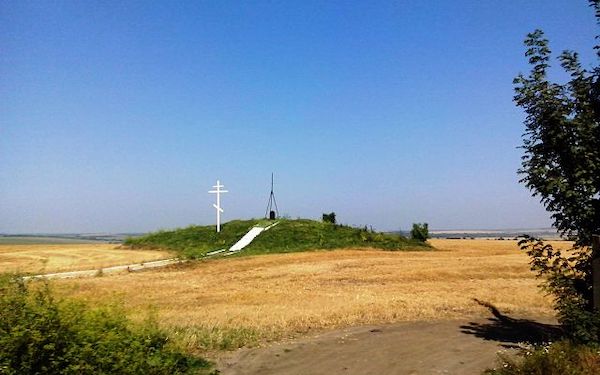
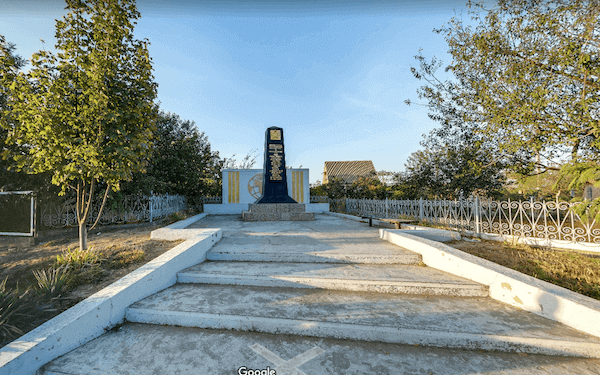
Two of Ukraine’s Struve Geodetic Arc locations: Felshtyn in Hvardiiske, Khmelnytsky Oblast © Volodymyr D-k / WikiCommons (left) and Staro-Nekrasivka in Nekrasivka, Odesa Oblast © Google maps (right)
How to get to the Struve Geodetic Arc and visiting information
You will have to be obsessed with visiting every UNESCO World Heritage Site in the world, to spend time visiting all 34 points of the Struve Geodetic Arc, or even the four in Ukraine. We’ve been to the Struve Geodetic Arc monument in Hammerfest, Norway and that is enough for us to say we’ve “done it”. This one is unlikely to be high on your list of UNESCO World Heritage Sites in Ukraine to visit!
Chances are, not that many will be looking up directions to the Struve Geodetic Arc in Ukraine, but curiosity got the better of me so I will include the information.
To see the three sites in Khmelnytsky Oblast, you will need to get to the main town of the province; Khmelnytsky. The city is a major transport hub with frequent buses and trains to many places, including direct trains to Kyiv, Lviv and Odesa. The Struve Geodetic marker points are all in fields near Khmelnytsky’s outlying villages:
– Antonivka (30 km northwest), a marker about 800 metres from the main road leading into the village;
– Felshtyn (30 km west), a plaque on a mound in a field a short distance from the road;
– Baranivka (45 km south), a marker resembling a gravestone.
You might be able to take a marshrutka bound for small towns and villages, but more than likely you will need to have your own transport or hire a taxi. The fourth Struve Geodetic Arc in Ukraine is in Odesa Oblast in the village of Staro-Nekrasivka near the town of Izmail. It is approximately 265 km southwest of Odesa and about 100 km east of Galati in Romania, but you have to pass through Moldova. The marker point is a small obelisk monument on the side of the road.
We investigated ways of getting to this part of Ukraine when we were visiting the Danube Delta in Romania, and it’s not easy to reach – impossible by public transport and a long way from anywhere even with your own transport. If we ever get to see the Struve Geodetic Arc in Staro-Nekrasivka, it’s because we’ve made it to the Danube Delta in Ukraine and not because we feel compelled to see the monument!
Ancient and Primeval Beech Forests of the Carpathians and Other Regions of Europe (2007,2011,2017)
Location: Western and Southwestern Ukraine
Ukraine’s only UNESCO World Heritage Site listing in the Natural category is a forest. Or more accurately, swathes of ancient beech forest that have expanded across Europe over hundreds of years. The listing encompasses 78 locations in 12 European countries, fourteen of which are in Ukraine, most of them in the south-westerly Carpathian region of Ukraine.
The Beech Forests of the Carpathians earned themselves a place on the World Heritage list because of the endurance and longevity of a species of flora. The European Beech has been spreading across Europe since the end of the Ice Age, starting from isolated regions of the Alps, Carpathians, Dinarides, Mediterranean and Pyrenees. UNESCO recognises the beech forests because their “successful expansion across a whole continent is related to the tree’s adaptability and tolerance of different climatic, geographical and physical conditions”.
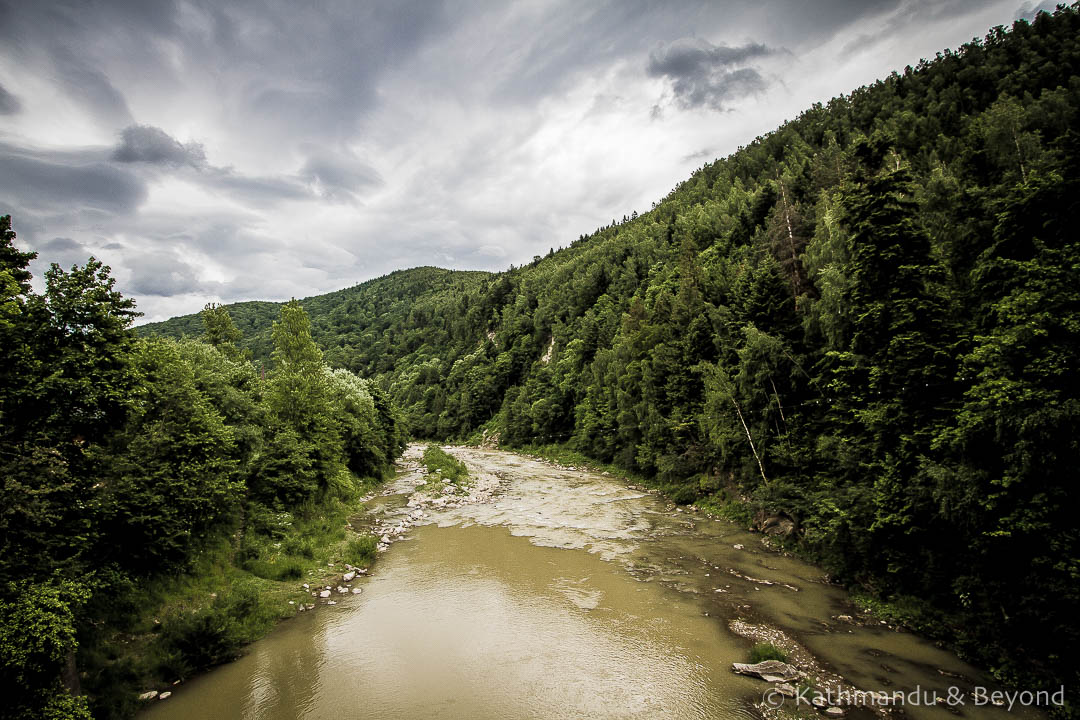
Yaremche in the Carpathians
How to get to the Ancient and Primeval Beech Forests of the Carpathians in Ukraine and visiting information
Most visitors to the Carpathian region of Ukraine base themselves in Yarameche where travel companies offer hiking, rafting and cycling trips and guided tours of the area. Another option is to stay in Rakhiv, a small town which is a growing centre for hiking and other outdoor activities. Rakhiv and Yaremeche are both on the (slow) train line and there are plenty of buses, but generally, the Carpathian towns are easy to travel to.
Many of areas that fall into the UNESCO listing are in the surrounding Carpathian Biosphere Reserve. Experienced Ukrainian or Russian speaking walkers might be able to hike independently although a guide is recommended. All of the areas are marked on the map.
One of the most accessible listings is the Roztochya Nature Reserve which is 30 km northwest of Lviv. With your own transport, it can be visited from Lviv, or you can take an organised excursion.
Residence of Bukovinian and Dalmatian Metropolitans (2011)
Location: Chernivtsi, Southern Ukraine
The Residence of Bukovinian and Dalmatian Metropolitans, built as a residential palace for a former bishop of the Eastern Orthodox church, was awarded UNESCO status due to it being an “outstanding example of 19th-century historicist architecture”. Historicism is another term for revivalism and was the main architectural style of the 19th century, with characteristics which revive historic architectural styles and combine them in an eclectic way. UNESCO believes the buildings display a “masterful synergy of architectural styles” with influences from the Byzantine period onward and reflecting the Austro-Hungarian Empire policy of religious tolerance.
A university was founded on the site in 1875 and today much of the complex is occupied by Chernivtsi National University. The grand red-brick building is resplendent with turrets and towers and is Ukraine’s very own Hogwarts. It is also one of the city’s main tourist attractions. Chernivtsi could be considered one of Ukraine’s hidden gems and is worth including on an off-the-beaten-track itinerary.
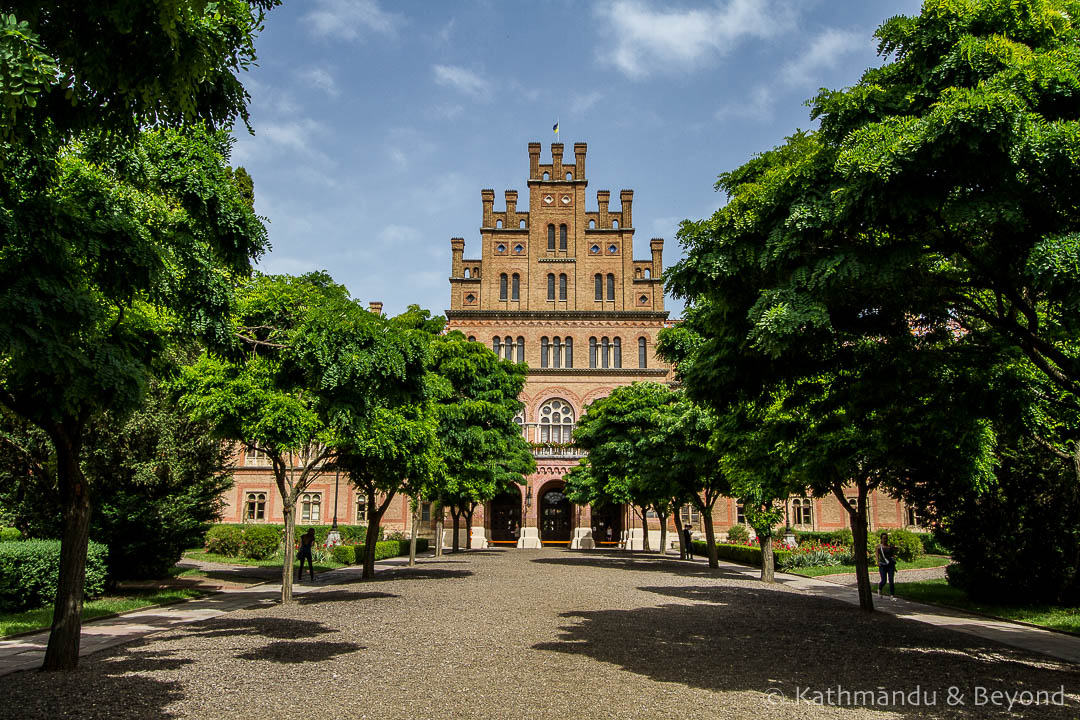
Palace Residence of Bukovinian and Dalmatian Metropolitans (Chernivtsi University) in Chernivtsi
How to get to the Residence of Bukovinian and Dalmatian Metropolitans (Chernivtsi National University) and visiting information
Chernivtsi is located in southwest Ukraine, approximately 35 km north of the border with Romania. There are overnight trains from Kyiv to Chernivtsi and Chernivtsi to Odesa, as well as connections from Lviv, Ivano-Frankivsk and Kolomya. If the train timings don’t fit, there are plenty of buses and marshrutkas. You can also take a bus from Chernivtsi across the border into Romania and Moldova.
The Residence of Bukovinian and Dalmatian Metropolitans / Chernivtsi National University is about a 10 to 15-minute walk from the town centre. Alternatively, you can take a bus (#5, 5A, 22) or trolleybus (#1, 2, 4, 8) to Derzhuniversytet bus stop.
Wooden Tserkvas of the Carpathian Region in Poland and Ukraine (2013)
Location: Southeastern Ukraine / The Carpathians
The collection of ancient wooden churches of the Carpathians is the third UNESCO site shared with other countries. There are eight inscribed tserkvas (churches) in Ukraine (and eight in Poland). The churches were built using horizontal wooden logs by Orthodox and Greek Catholic communities between the 16th and 19th centuries and have survived in excellent condition to this day.
“The tserkvas bear testimony to a distinct building tradition rooted in Orthodox ecclesiastic design interwoven with elements of local tradition, and symbolic references to their communities’ cosmogony*” UNESCO
* UNESCO uses a lot of words that I have to look up: Cosmogony explains the origin, evolution, and eventual fate of the universe, from a religious perspective.
The wooden churches are all in the Carpathian region of southwest Ukraine and southeastern Poland. Those in Ukraine are clustered in the area around and south of Lviv, towards Rakhiv and are:
Tserkva of Saint George in Drohobych (N49 20 51.85 E23 29 58.80)
Tserkva of the Synaxis of the Blessed Virgin Mary (St. Dmytro’s Church) in Matkiv (N48 54 55.70 E23 6 32.00)
Tserkva of the Nativity of the Blessed Virgin Mary in Nyzhniy Verbizh (N48 29 55.16 E25 0 41.29)
Tserkva of the Descent of the Holy Spirit in Potelych (N50 12 31.00 E23 33 3.00)
Tserkva of the Descent of the Holy Spirit in Rohatyn (N49 24 37.00 E24 36 10.49)
Tserkva of the Synaxis of the Archangel Michael in Uzhok (N48 59 1.54 E22 51 15.61)
Tserkva of Our Lord’s Ascension in Yasynia (N48 16 30.00 E24 21 11.00)
Tserkva of the Holy Trinity in Zhovkva (N50 3 19.22 E23 58 55.97)
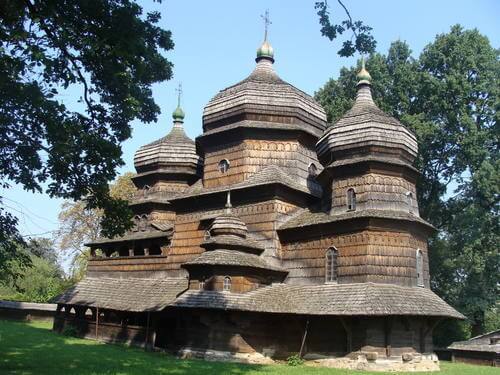
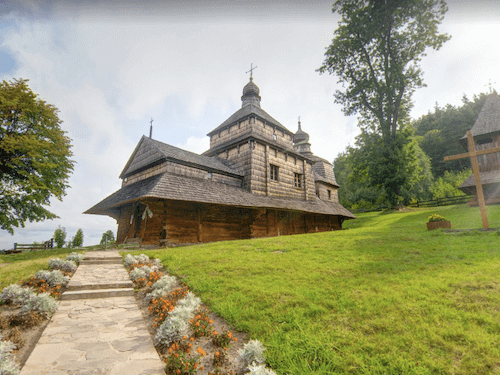
Tserkva of Saint George in Drohobych © V. Slobodyan / UNESCO (left) and Tserkva of the Descent of the Holy Spirit in Potelych © Google maps (right)
How to get to the Wooden Tserkvas of the Carpathian Region and visiting information
All of Ukraine’s UNESCO-listed wooden churches are marked on the map at the top of this post.
The most accessible wooden churches for independent travellers are the ones that can be visited as a day trip from Lviv. It is possible to visit more by basing yourself in one or more of the Carpathian towns: Mukachevo, Yaremeche, Kolomyya or even Ivano Frankivsk. However, if you want to see more than a couple of tserkvas, and don’t want to spend a week or more doing so, it is more practical to take a tour or hire a taxi.
At 30 kilometres from the centre of Lviv, you can visit the Church of the Holy Trinity in Zhovkva as an easy day trip. The Church of Saint George in Drohobych and the Church of the Descent of the Holy Spirit in Rohatyn are both approximately 70 km from Lviv and are also possible to visit in a day. These towns all make good day trips from Lviv and have sights other than the churches but they are in different directions so you won’t be able to visit them in one day if using public transport.
The Church of Our Lord’s Ascension is in the village of Yasynia, on the Rakhiv – Yaremche road, about 30 km from Rakhiv and 50 km from Yaremche. You could visit on public transport by taking a marshrutka to Yasynia from where the church is about a kilometre from the main road.
From Kolomyia, the Tserkva of the Nativity of the Blessed Virgin Mary in Nyzhniy Verbizh is 6 km away. It’s 1½ km from the main road so be prepared for a short walk.
You can see all of Ukraine’s UNESCO-listed wooden tserkvas from the comfort of your armchair on a virtual tour from Authentic Ukraine.
Ancient City of Tauric Chersonese and its Chora (2013)
Location: Crimea
Chersonese (also written as Chersonesos) is an ancient Greek colony founded approximately 2,500 years ago. Today the site is located on Ukraine’s far southern Crimean Peninsula, on the outskirts of Sevastopol in an area designated as the National Preserve of Tauric Chersonesos. Historically Crimea was known as Tauric Chersonese, and its inhabitants were the Tauri people. Chora is the name given to the land and estates surrounding Chersonesos and its people.
UNESCO listed the Ancient City of Tauric Chersonese because it is “an outstanding example of democratic land organisation linked to an ancient polis, reflecting the city’s social organisation”.
Various parts of the ancient civilisation are spread out over quite a small area where you can see remains of the amphitheatre, the so-called ‘Basilica in the Basilica, Uvarov Basilica, Zenon Tower and the Museum of Chersonesos.
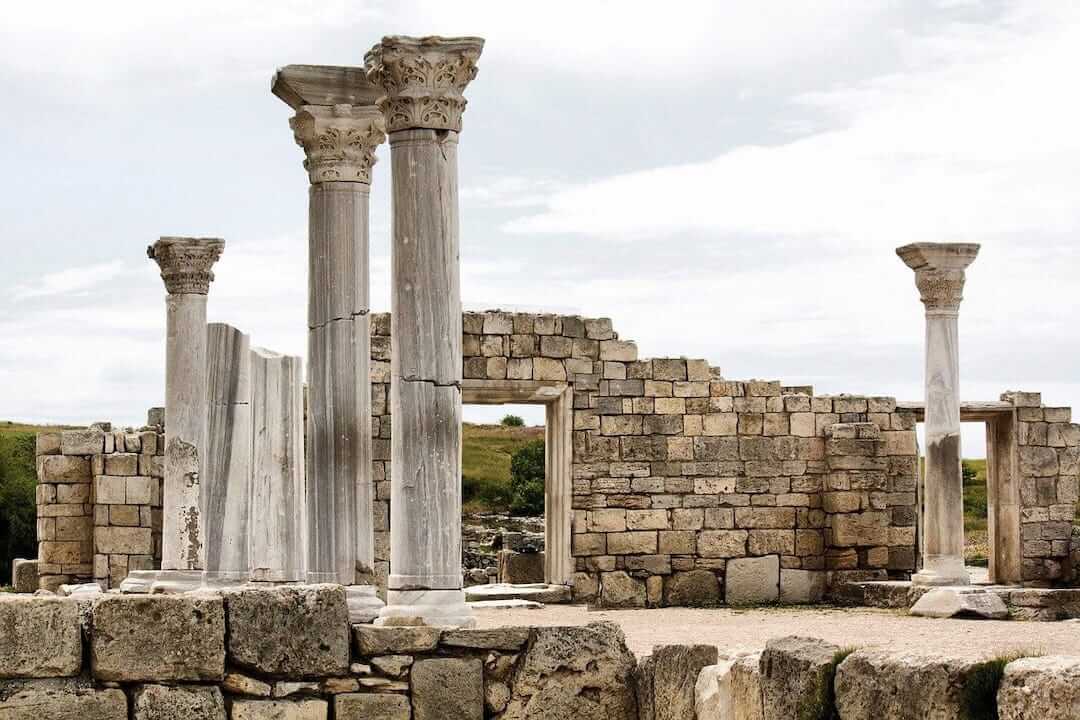
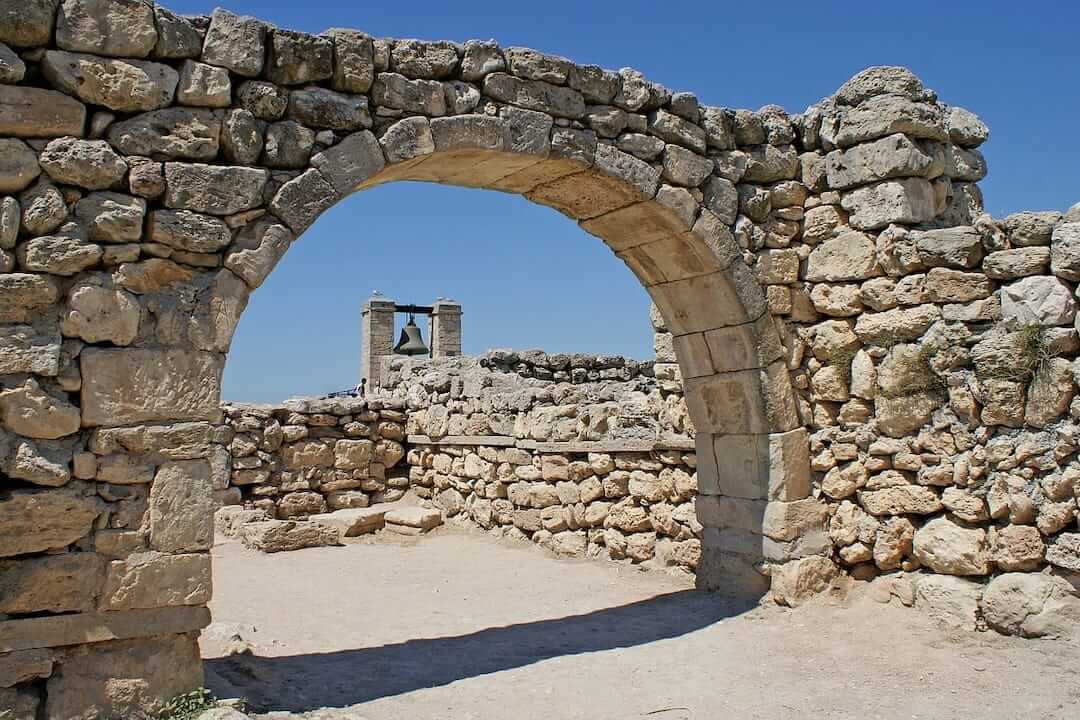
The Ancient City of Tauric Chersonese, ones of the seven UNESCO World Heritage Sites in Ukraine (image credits left: Юрий Лютый and right; Jørgen Deleuran)
How to get to the Ancient City of Tauric Chersonese and its Chora and visiting information
Chersonese is, potentially, one of the most inaccessible World Heritage Sites in Ukraine. Before going any further, you should remember that Crimea is subject to a territorial dispute between Ukraine and Russia and most Western governments (including the UK’s Foreign, Commonwealth & Development Office) advise against travelling to Crimea. Russia annexed Crimea in 2014, and Sevastopol and the Crimean Peninsula is administered as a federal city of the Russian Federation. Ukraine and the majority of international governments regard Crimea as part of Ukraine.
The next complication is whether you enter Crimea from Ukraine (almost impossible as a tourist) or from Russia? This isn’t a can you?/should you?/how can you visit Crimea? guide but if you make it to Sevastopol, finding the ancient city sites should be a breeze! The National Preserve of Tauric Chersonesos is approximately four kilometres west of Sevastopol. You can take a bus or marshrutka from Sevastopol. Check the best route on EasyWay.
We hope you’ve found our guide to the UNESCO World Heritage Sites in Ukraine helpful. How many have you visited and which ones do you plan to see next?
Note: this post is intended as a general guide and opening hours and visiting restrictions may currently apply at some of the sites.
PIN OUR GUIDE TO VISITING THE UNESCO WORLD HERITAGE SITES IN UKRAINE
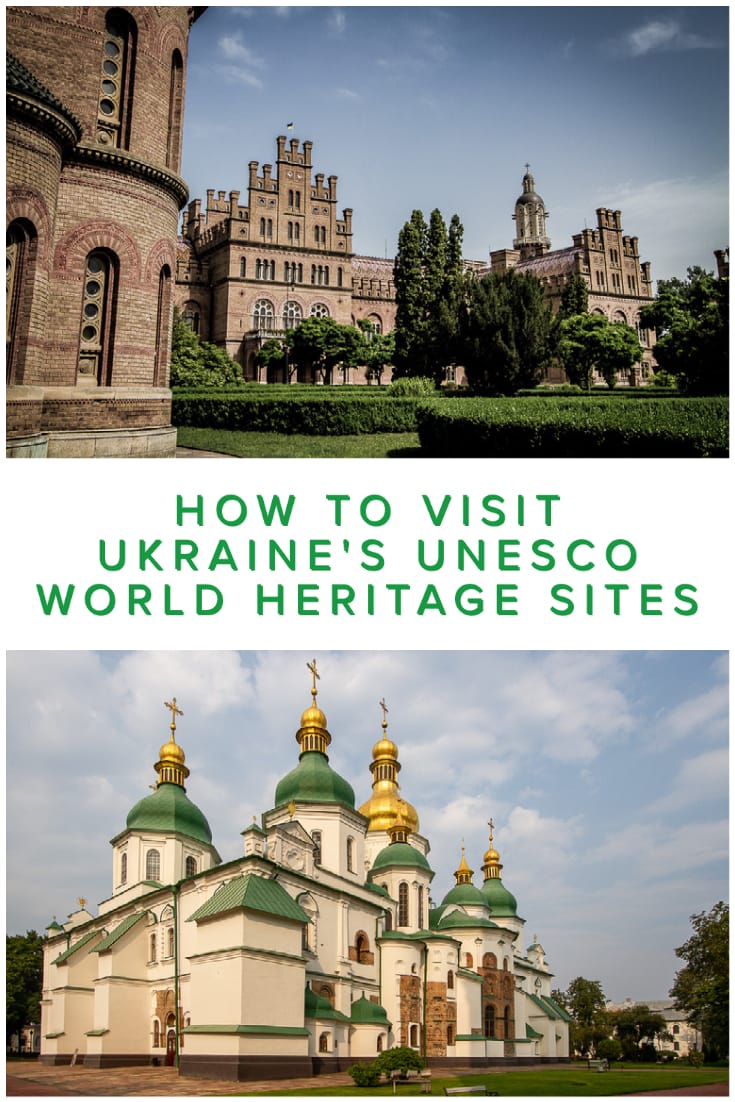
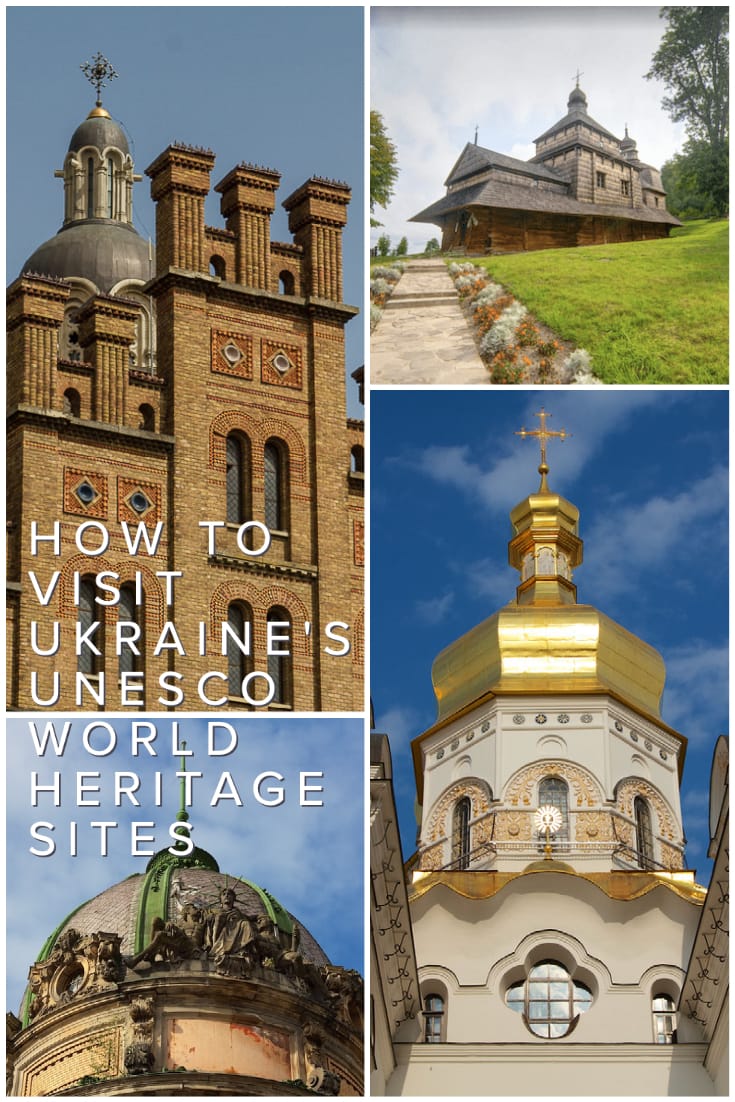
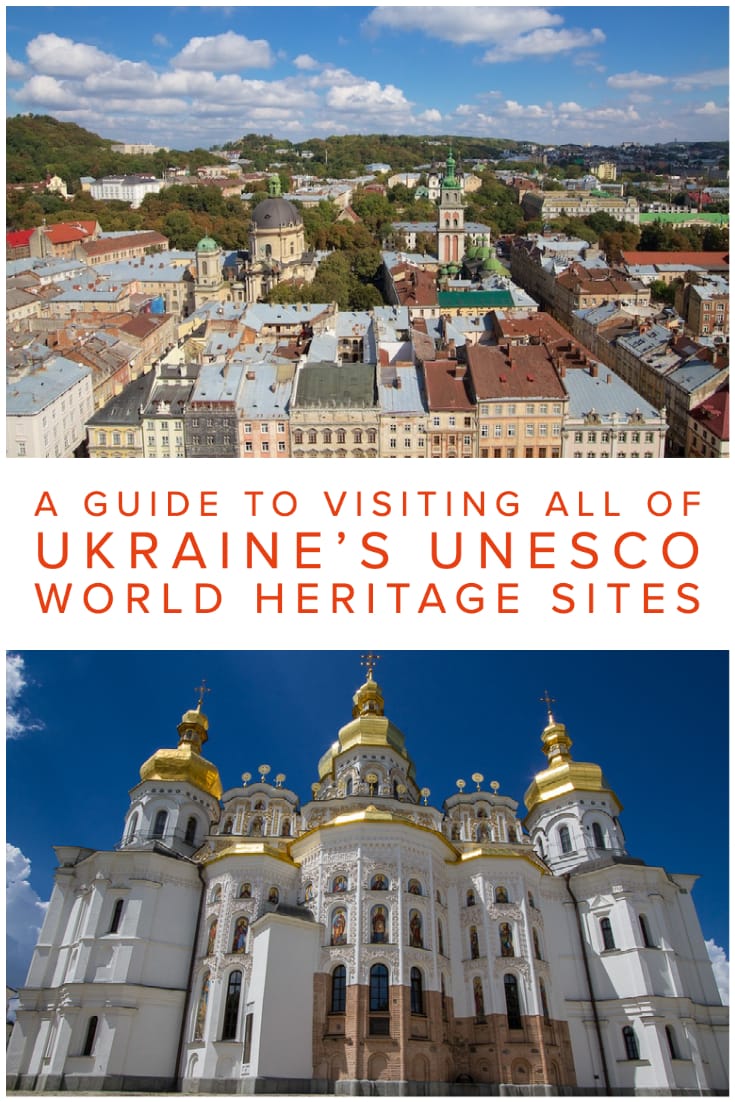
Some of the descriptions in this post are reproduced from UNESCO’s website under license CC-BY-SA IGO 3.0.
